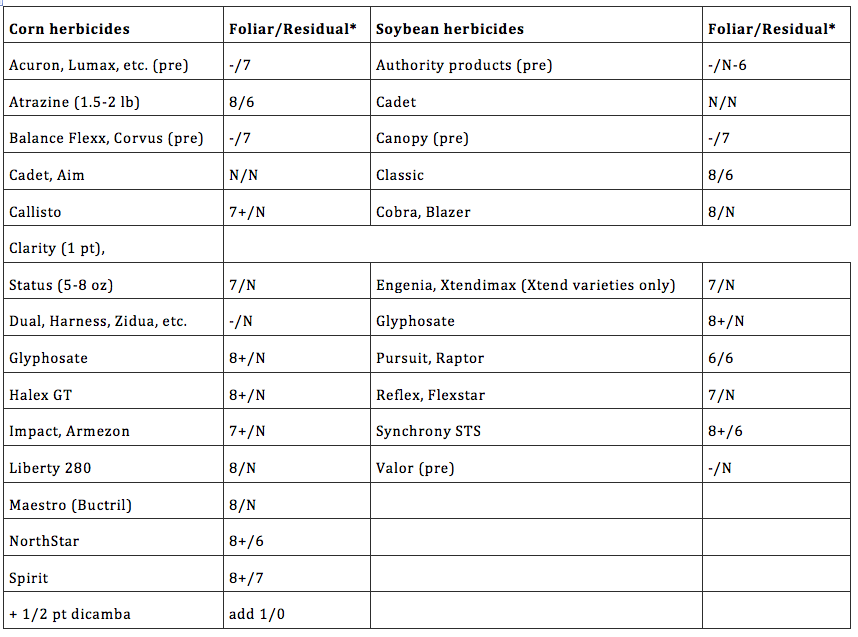Burcucumber seed are the size of a watermelon seed, can germinate from mid-May through September, and the seedlings can emerge from up to six inches deep. Because burcucumber germinates throughout the season, it is difficult to control with herbicides that lack residual activity.
Penn State weed scientists conducted several studies on burcucumber in the late 1990s. Many of those research findings are still relevant today. Since then, other universities also have conducted field studies that provide additional insight into the management of burcucumber.
Management considerations
The first step in management is to prevent burcucumber seed spread by thoroughly cleaning farm equipment before leaving infested fields. Encourage aggressive crop growth through good cultural practices, such as maintaining adequate soil fertility, choosing appropriate high-yielding crop varieties, and regularly scouting for and managing pests.
Include in the rotation crops that provide early competition such as alfalfa or small grains. Include no-till in fields that are infested with burcucumber. Research suggests that no-till allows burcucumber seed to remain near the soil surface, thus allowing germination to occur over a shorter time period and more uniformly which reduces the number of germination flushes. This also improves herbicide effectiveness and performance.
Tillage buries some seeds at lower depths which causes a season-long germination pattern to occur. With a lack of residual control, these later emerging seedlings can be difficult to manage. Harvest burcucumber infested fields for silage to prevent viable seed production.
Studies at Penn State have shown that immature burcucumber seed that is cream/tan-colored can be effectively killed by the ensiling process. Once the seeds turn dark brown or black, they are difficult to kill.
Corn
Herbicides are essential in a burcucumber management program, but use them in combination with other control methods. One-pass herbicide programs will not work. Effective management must include both pre and post (foliar-applied) herbicides. Post programs that include effective foliar and residual herbicides will enhance season-long control. Several corn herbicides provide good control of burcucumber (Table 1) and they are most effective on young seedlings rather than larger plants.
Include herbicides that have residual activity to control new burcucumber flushes. Post herbicides provide the best burcucumber control. In corn, if possible, include at least 1.5 pounds of atrazine in the herbicide program for residual control.
Other effective herbicides include prosulfuron (Peak or Spirit), primisulfuron (Beacon), mesotrione (Callisto), and glyphosate. In addition, other Group 6 herbicides such as bromoxynil (Maestro/Buctril) are effective for controlling emerged plants.
Some two-pass programs that have proven effective include the use of products such as Lumax, Lexar, Acuron, Corvus + atrazine, or Balance Flexx + atrazine preemergence followed by glyphosate plus Sprit or Callisto applied postemergence. Other post options include: atrazine, dicamba/Status, NorthStar, Halex GT, Maestro, and Liberty 280. Prosulfuron (Peak), a component of Spirit, provided the best season-long control of burcucumber in Penn State field research.
For example, tankmixing Peak at 0.25 ounce per acre with Spirit (1 ounce) typically improves and extends control, but watch out for long recrop restrictions.
Soybeans
Burcucumber may be easier to manage in soybeans than in corn simply because you can better monitor control and apply herbicides later in soybeans than in corn. Split-applications might be necessary for best control of later emerging burcucumber seedlings.
The most effective herbicides (Table 1) for control in soybeans are glyphosate plus a residual product like chlorimuron (Classic). More than one post application may be necessary. Liberty 280 also has activity in LibertyLink varieties.
Table 1. Effectiveness of selected corn and soybean herbicides on burcucumber control.

* Effectiveness ratings: 9 = 85 to 95%, 8 = 75 to 84%, 7 = 65 to 75%, 6 = 55 to 65%, N = less than 55%/no activity
Late season management
Wet weather, especially late in the season, is ideal for burcucumber seeds to continue germinating and become a problem in corn and soybean fields. Since it is so late in the season, burcucumber vines usually don’t get above the crop canopy and often go unnoticed. At this late stage in corn, there are few options for managing this troublesome weed.
Glyphosate, Gramoxone, Impact/Armezon, and 2,4-D are the only typical pre-harvest herbicides that have some activity. However, Beacon (applied before tassel emergence) and Maestro (formerly Buctril) can also be sprayed until tassel to slow burcucumber.
As harvest-time, the pre-harvest applications are targeting grain production prior to a frost and really are intended just to allow combine harvest of the crop. Gramoxone is probably the most effective of these options at this time.
In soybeans, of the available harvest aids, only glyphosate, Gramoxone, and Clarity would have any activity on burcucumber. Again, Gramoxone is probably the most effective of these treatments for burcucumber suppression.
Key points to burcucumber management
- Avoid spreading the seed via harvest or tillage equipment
- Use no-till practices to keep the seeds on the soil surface
- Plant shorter season corn varieties to allow earlier silage harvest
- Ensiling kills green/immature burcucumber seed
- Two-pass programs that include effective foliar and residual herbicides is required for season-long control
- Pre-harvest burcucumber control is usually not effective






